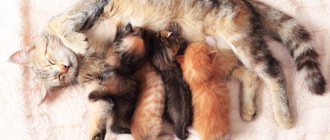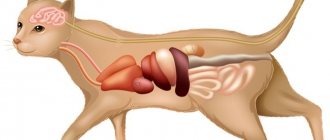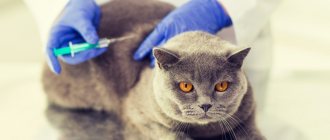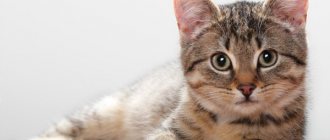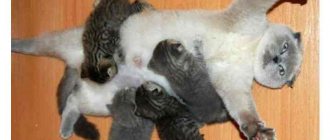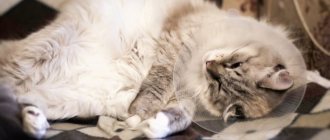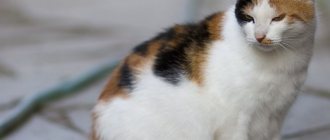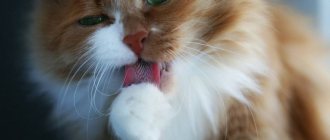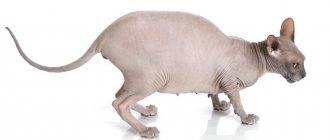When giving birth independently, your pet often experiences complications in the form of retained placenta. If the cat does not have an afterbirth, what should you do in this situation? This issue worries not only beginners, but also experienced breeders, as it poses a threat to the health and sometimes the life of the animal.
This is due to the rapid development of not only the inflammatory process in the uterus, but also the threat of septicemia (blood poisoning). That is why it is important to quickly recognize the retention of the placenta and provide urgent assistance to the animal.
First birth of a cat
Starting from 7-9 months, the cat is capable of reproduction. But don’t rush things: it’s much better if the pussy turns one year old, when 3-4 heats have passed. If the mating is successful, the cat's birth calendar will help calculate the timing of the birth of the offspring.
The first time is scary for everyone: both the cat and the owner. But nature took care of the animal’s strong instincts, so sometimes it’s enough for a person to just be nearby.
The first birth is quite normal if the cat is healthy. First, contractions intensify, followed by a reduction in the intervals between them.
After pushing, the baby appears, but first amniotic fluid will come out of the birth canal. The cat will want to sit down while the kitten is coming out, this should not be allowed!
The interval between the appearance of kittens during the first birth can frighten the owner - a break of up to one and a half hours is considered the norm, and labor itself lasts from several hours to one day. In some cases, labor lasts up to 36 hours
Since the cat is inexperienced, you can help her during childbirth and cut the umbilical cord with scissors at a distance of 2 cm from the kitten’s belly.
Preparing for childbirth
If according to signs the cat is expected to give birth within the next 24 hours, then you definitely need to prepare for this. It’s better to do this in advance, a few days in advance, so that everything is at hand. All preparation is carried out in several stages.
Preparing the birth site
The expectant mother must get used to the parenting place in advance. Therefore, the box in which the birth will take place should appear in the house at least a week before the significant event. If this is not done, the pet will choose its own place. This could be a closet or just a secluded corner. At the same time, it is almost impossible to convince the pet to move into the box in this case.
Box requirements:
- the cat should be able to stretch out to its full height inside, and at the same time there should be enough space for the kittens;
- the height of the container should be approximately half a meter;
- the exit must be made in such a way that the mother can calmly get out and go back in, but the kittens cannot;
- A small soft pillow should be placed on the bottom, which should be wrapped in a waterproof cloth, and an absorbent cloth should be placed on top.
If before giving birth the cat did not enter the prepared house on its own, then it should be carried and placed inside. At the same time, she needs to be stroked and calmed down, and made to understand that it is better to give birth to offspring here.
Preparing tools
Owners should have everything they need on hand:
- lots of rags;
- several pairs of sterile gloves;
- sterile bandages and napkins;
- surgical thread for tying the umbilical cord; a couple of hours before birth, they should be placed in a container with alcohol for disinfection;
- small scissors with rounded ends;
- a baby syringe, which will be needed to suck out liquid from the nose or mouth;
- scales, a writing object, blank paper, a watch to record and record all events;
- disposable syringes;
- a garbage bag to store used materials and tools.
Medications
Stock up on a small first aid kit, which should contain:
- hydrogen peroxide;
- brilliant green or potassium permanganate;
- alcohol, cognac or other alcoholic drink;
- oxytocin.
Stages of lambing for a cat
Labor is divided into three stages:
Contraction of the uterus and its gradual opening. The external symptom is discharge - the mucous plug that covers the entrance to the cervix comes out. Contractions appear and become more frequent.
Increased frequency of contractions, complete opening of the cervix. The movement of the fetus along the birth canal into the second phase is accompanied by the mother cat’s attempts to push the baby out: the animal tenses. Kittens are born mainly in the amniotic sac. If the new mother did not help the child cleanse himself of it and did not lick it, then a person should help - carefully use scissors to make an incision on the bubble in the area of the muzzle, and the kitten itself is wiped with a cloth. Usually the female, on her own, carries out the procedure of breaking the bladder and licking its remains from the kitten’s body. The duration is 5-60 minutes.
The kitten did not come out an hour after the start of this stage? Urgent call to the vet!
Once the baby is born, the placenta begins to come out, which the mother can eat after the kitten has been licked. It is better to remember how many placentas came out - there should be as many of them as kittens.
The kitten finds the nipple, labor resumes, and the next cub appears. The interval between two kittens can be from 10 to 60 minutes.
The whole process takes on average 6 hours.
Induction of labor
If the due date has come, the cat’s body temperature has dropped to 37°C, more than two days have passed, then you need to know how to induce labor in a cat. First, they try simple remedies: massage the tummy and nipples: this will cause the production of oxytocin, and it will start the process of contractions. It is dangerous to administer oxytocin on your own - physiological unpreparedness for lambing can lead to cervical rupture.
If two days have already passed, signs of labor are evident, but the process has not started, then contact a veterinarian.
Starting from 7-9 months, the cat is capable of reproduction. But don’t rush things: it’s much better if the pussy turns one year old, when 3-4 heats have passed. If the mating is successful, the cat's birth calendar will help calculate the timing of the birth of the offspring.
Pregnancy and childbirth (lambing) in cats are natural processes characteristic of unsterilized pets. In most cases, they proceed without complications, but sometimes the owner’s help is required. Complications are typical for primiparous, purebred and dwarf cats, as well as for those who are sick with congenital or acquired pathologies. In such cases, mandatory provision of step-by-step assistance is required throughout the entire lambing.
How to recognize the onset of labor
Inexperienced owners worry more than their pets. They ask in advance how to understand that a cat has started giving birth, and how long to wait for the kittens to appear. Veterinarians advise monitoring the behavior and well-being of your pet throughout pregnancy. This will help you easily recognize changes at an early stage.
Behavior of the expectant mother
The first signs of labor in a cat involve behavior. The expectant mother is nervous, anxious, constantly looking for a secluded corner and trying to build a nest. Because of this, it is important to accustom her to a prepared box in advance.
A pregnant woman's appetite decreases to the point of hunger strike. She constantly licks the external genitalia, and a few hours before lambing begins to arch her back. With a strong attachment to the owner, the animal begins to attract his attention by meowing.
Physiological signs
Physiological signs include swelling of the mammary glands, the appearance of lactation and a decrease in body temperature to 37 °C. The pregnant belly drops and takes on the shape of a pear. The frequency of going to the toilet increases. 1-2 days before the onset of labor, the mucous plug comes off. It is difficult to notice the passage of water, since the secreted mucus is constantly licked out.
Hormones prolactin and lactation hormone
The hormone prolactin is a “maternal behavior” hormone and a lactation hormone.
Stages of childbirth in detail.
Childbirth is divided into 3 stages, each stage has its own time interval.
The intervals and duration of labor are unpredictable, and past births are not an indicator. One time an animal can give birth in a couple of hours, another time the birth will last almost a day and both options can be the norm.
Stage 1 – harbingers of labor.
This is the most painful stage for the animal and the owner. Behavior changes as the uterus contracts, but we do not see this in the abdomen. The dog (cat) is breathing heavily and digging or making a nest. The period can take up to a day. To confirm the onset of labor in dogs, a progesterone test can be done. Its decrease confirms the onset of labor.
Exception: In cats, progesterone is also produced by the placenta, so the drop in progesterone will not be as significant as in dogs. A strong decrease in cats occurs only the day after birth.
Similarly, in the case of “single puppy/kitten syndrome”, one fetus may not cause such a cascade of reactions, as a result of which pregnancy may be delayed. And there is no decrease in temperature, since progesterone does not drop and labor does not begin for a long time.
Description of the birth process
Inexperienced owners are primarily concerned about the length of the process. The condition of newborns and their possible number are also important.
How long does labor last?
It is impossible to give an exact figure that determines how long a cat’s labor lasts. This indicator is individual. It depends on age, breed and general health. Typically the entire process takes 4-12 hours. If the duration lasts for a day, it is recommended to contact a veterinarian. A negative prognosis is typical when it reaches 48 hours. In this case, urgent surgery is required to save the animal and its offspring.
We recommend reading: I’m burying my cat’s ear and his mouth is leaking
You can determine how long it will take for a cat to give birth to the next baby by looking at its order. The first two take the longest to come out. The wait may last for several hours. The birth time of the remaining kittens is a few minutes.
How many kittens can be born?
When talking about how cats give birth, it is necessary to note the size of the possible litter. On average, the number of newborns ranges from 2 to 6. Their number depends on the previous pregnancies, breed and age of the woman giving birth. A small number of newborns (1-3) is typical for primiparous, elderly and small pets.
What do newborn kittens look like?
The weight of newborns is 80-120 g, and their body length is 9-12 cm. They are born deprived of sight and hearing, so they really need help from their mother or a person. At first, they sleep constantly and eat a lot. Due to fragile bones, babies cannot stand on their feet. They navigate with the help of a developed sense of smell and touch and use a thin squeak to communicate. At first it is better not to touch them. It is enough to monitor their weight.
How to determine the end of a process
The absence of contractions for 2 hours indicates the end of labor. Full recovery of the body takes 2 weeks. During this time, newborns grow up and become more independent.
The cat's mucus plug came off
As a rule, the period of release of the mucus plug takes several hours. Having noticed a mucus plug, the owner should be on alert. The following symptoms may indicate the upcoming birth process:
- Showing attention to the genitals, swelling of the loop and change in its color. Under normal conditions there should be no discharge.
- Reduced animal activity. The pet prepares for the upcoming birth, becomes detached, and sometimes thoughtful. You cannot force a cat to be active.
- Loss of appetite. The cat refuses food and may be constantly thirsty.
- Specific stretching of the body, indicating the onset of contractions. This behavior means that the birth process has begun and the uterus is contracting.
In addition, a woman in labor, especially a firstborn, begins to meow loudly out of fear, trying to hide from prying eyes. It is recommended to close all hiding places and stop access to closets and closets for the cat.
It is important that the owner is always nearby, constantly petting the pet, talking to her in a gentle voice. It is forbidden to shout at an animal, even if it behaves inappropriately (for example, crawling under the blanket or ruining the sheets).
The onset of impending labor is also accompanied by the following symptoms:
- lowering of the abdomen - it takes on the shape of a pear;
- trips to the toilet become more frequent due to the pressure of the uterus on the bladder;
- release of the mucus plug;
- loss of water, accompanied by constant licking of the cat in the loop area;
- rapid breathing (shortness of breath).
The first baby appears after the onset of strong contractions for several hours.
Attempts that occur after contractions and last longer than 3 hours are considered pathological. In this case, you must urgently contact your veterinarian.
As a rule, prolonged labor in a pet begins to be accompanied by the appearance of an unpleasant odor. It is possible that the animal will need to undergo surgery.
How to deliver babies of varying degrees of complexity at home
Assistance to the woman in labor depends on the severity of the lambing. It is impossible to predict its outcome in advance, so you will have to act according to the situation.
Lungs
For mild lambing, no intervention is required. You just need to ensure the safety of newborns. During labor, the mother may crush them, so place the kittens in a separate box until the last baby appears.
Compare the number of newborns and placenta. The lack of placenta is caused by getting stuck inside the womb, leading to inflammation. You will have to remove it yourself by wrapping your fingers in a clean bandage. If pus, mucus or blood appears, lambing is considered moderate or severe.
Average
At the end of labor, the new mother independently gnaws the umbilical cord, eats the afterbirth and cleanses the newborns of mucus. If she did not do this, you will have to play the role of an obstetrician. Carefully cut the umbilical cord 4 cm from the abdomen, tie it with thread and treat the wound with an antiseptic.
Before cutting the umbilical cord, remove membranes from each kitten and clean their nasal passages and mouth using a pipette or bulb. If there is no breathing or a characteristic squeak, carefully fold the baby in half, rub him with a towel and gently shake him upside down.
Do not give your pet more than two afterbirths. They are rich in beneficial microelements and have a beneficial effect on the immune system, but cause gastric upsets if consumed in excess. If the bubble does not burst inside the vagina, the pet may try to burst it along with the kitten. Discourage this action by noticing a bubble emerging from the vagina. After the newborn arrives, carefully open the amniotic sac, being careful not to touch the tiny body.
Complex
Complex cases include stopping labor. This can happen when the fetus gets stuck or several babies are pushed out at the same time. To save them, you will have to wear disposable gloves, lubricate your fingertips with Vaseline and carefully insert them into the vagina in an attempt to grab the withers. Avoid paws. They are too fragile and can be easily damaged. Pull your newborn out using gentle rocking movements.
If you notice an unpleasant-smelling brown fluid coming out of the vagina or prolonged labor, you should contact your veterinarian. It is also recommended to clarify in advance the number of future offspring using an ultrasound scan, so as not to miss the stuckness of the fetus.
Soft bedding or blanket. Place a disposable baby diaper under them to prevent the cardboard from getting wet.
When giving birth independently, your pet often experiences complications in the form of retained placenta. If the cat does not have an afterbirth, what should you do in this situation? This issue worries not only beginners, but also experienced breeders, as it poses a threat to the health and sometimes the life of the animal.
This is due to the rapid development of not only the inflammatory process in the uterus, but also the threat of septicemia (blood poisoning). That is why it is important to quickly recognize the retention of the placenta and provide urgent assistance to the animal.
What is afterbirth, the causes of problems with it
In order to competently provide assistance during childbirth, in time to suspect the retention of the placenta in the uterus, it is necessary to understand what a cat’s placenta is. Normally, the birth act in all animals ends with the separation of the membranes, the so-called afterbirth (placenta, baby's place). During intrauterine development, the placental membranes provide a physiological connection between the mother’s body and the developing fetus. With their help, the supply of nutrients and oxygen occurs, as well as the utilization of metabolic products of growing fruits.
The afterbirth came out with the kitten
During childbirth without complications, after the kitten is born, its baby's place comes out either after it or after a few minutes. Each newborn has its own placenta, so the number of kittens born must correspond to the number of membranes released. Owners often wonder how long it takes for a cat to lose its placenta. Veterinary experts consider it normal for the membranes to rupture within 3 hours after birth.
There are several reasons why a child’s place is detained:
- uterine atony (insufficient contractile function);
- premature cervical closure;
- inflammatory processes of the reproductive system (endometrium and placenta);
- accumulation of fluid in the amniotic membranes;
- stretching of the uterine tissue during the birth of large or large numbers of fetuses.
Predisposing factors are:
- overweight (obesity);
- underweight;
- lack of physical activity during pregnancy;
- inadequate feeding.
To prevent placenta retention, the owner of a furry pet should pay attention to keeping the cat during pregnancy. Physical inactivity, weight problems, lack of complete proteins, vitamins and minerals in the diet can lead to the development of complications in the form of delayed childbirth.
Threat to the animal
The owner of the animal must understand the threat this pathology of the birth process poses. Retention of the placenta in the birth canal can be complete or partial. If the child's seat has not separated at all, then we are talking about complete detention.
If the membranes do not come out completely, then this pathology is called partial retention of the placenta. In both cases, there is a threat of inflammation.
The open birth canal quickly becomes infected with microbes. In this case, putrefactive inflammation of the uterus occurs, since the cervix is not yet closed. An inflamed mother's womb is a good breeding ground for the development of bacteria, which easily penetrate the bloodstream and spread throughout the body, causing septicemia (blood poisoning). The animal becomes severely intoxicated.
Untimely assistance can lead not only to the loss of the ability to reproduce, but also to death. Therefore, owners must be present during the birth and monitor the expulsion of the pet’s placenta.
When to call your veterinarian?
- Pelvic fractures;
- Excessive obesity in a cat;
- Chronic disease or caesarean section performed on a wound;
- Discharge from the vulva is bright red or greenish in color without the onset of contractions;
- Long-term, over 68 days, pregnancy;
- Long, over 90 minutes, contractions without the release of kittens;
- Kittens getting stuck in the birth canal;
- Weak contractions without kittens coming out;
- The cat or kittens are very lethargic, they have white mucus on the tongue, gums, and around the eyes;
- Uterine prolapse;
- The cat refuses to eat within 24 hours after giving birth;
- The presence of foul-smelling discharge from the vulva;
- Temperature above 39.60 degrees;
- Lack of milk from a cat or her refusal to feed kittens.
What to do if there is no afterbirth?
If for some reason it was not possible to track the number of afterbirths released, then it is necessary to closely monitor the cat’s condition. Particular attention should be paid to:
- The nature of discharge from the birth canal. They should not be dark in color with a putrid odor.
- It is also advisable to monitor body temperature after childbirth. It should not exceed 39 C.
- It is also necessary to monitor the general condition. The animal should not be oppressed.
- Refusal to feed and weakness should alert you.
The presence of at least one of the above signs is a reason to contact a veterinarian.
When present at the birth of a pet, the owner should pay attention to such an issue as separation of the placenta. Knowing how many membranes a cat should have and how long it takes for them to leave the birth canal, you can prevent the development of complications and inflammatory processes after the birth of kittens. Timely diagnosis of retained placenta and seeking veterinary help will preserve the reproductive health of the pet, and even the life of the animal.
We recommend reading: Can a Cat Get Ringworm From a Human?
If the cat does not have an afterbirth, it is important for the owner to provide first aid to the pet. The main danger of the problem lies in the fact that the delay causes the development of inflammatory processes in the uterus, which can lead to blood poisoning and death. If you can’t cope on your own, you need the help of a veterinarian.
Assistance during childbirth: diagnosis of retained placenta
When helping with childbirth, the owner should pay attention to how many afterbirths the cat has. To do this, it is necessary to count the kittens and the delivered placentas. Their number should be equal. The baby's place emerges from the birth canal after each kitten is born.
It's normal for a cat to eat an afterbirth. Quite often, cats eat afterbirths. This phenomenon is instinctive in nature. In the wild, the female must keep her nest clean to prevent predators and scavengers from finding it. In addition, childbirth requires a lot of energy expenditure from a cat and physically exhausts the animal. Under natural conditions, the mother cannot immediately leave the nest and look for food, so eating the placenta is vital.
Domestic beauties often act by analogy with their wild ancestors. Therefore, the owner must ensure that the cat does not eat the afterbirth. In cases where there is no control over the animal, diagnosing retained placenta will be difficult.
Eating the placenta itself is safe for the cat. Whether or not to allow the membranes to be eaten is up to each owner. There is no consensus among breeders on the appropriateness of this phenomenon.
Some believe that in this way the cat stimulates the contractile work of the uterus, and this facilitates the passage of subsequent membranes. Other breeders are categorically against this phenomenon, believing that there is no benefit in it. In any case, your pet should not be allowed to eat more than two placentas to avoid digestive problems (diarrhea, vomiting).
It is also important for the owner to know when the cat’s placenta comes out normally. This process is individual for each animal. In some cats, the passage of the placenta is observed literally after the birth of the kitten, in others - after half an hour or an hour. However, if more than 3 hours have passed and the membranes have not come out, you should immediately contact a veterinarian.
We recommend reading the article on how to understand that a cat is giving birth. From it you will learn about the signs of the onset of labor, the stages of birth of kittens and cases when you need to call a doctor.
[custom_ads_shortcode3]
Why is it dangerous?
For an animal, such a pathology can result in infection entering the bloodstream.
Detention of the birth place can be partial or complete. If we talk about the latter, the afterbirth does not separate completely. A partial delay is observed when the shells do not come out completely.
Both of these conditions are fraught with the rapid onset of inflammatory processes, since the open birth canal infects pathogenic microorganisms. As a result, purulent inflammation of the uterus is often observed. Pathogenic bacteria enter the bloodstream, spreading throughout the body and causing blood poisoning.
Veterinarians note that the norm for the discharge of the membranes is 3 hours. If the cat has not eaten the afterbirth, there is no reason to panic. Eating the placenta is characteristic of wild animals, which protect their territory from predators by maintaining cleanliness.
How does childbirth occur in cats?
Cats bear offspring for approximately 2.5 months. During one birth, 1-2 kittens are born, as well as 6-7. The process itself takes several hours and consists of several stages. If you are helping your cat give birth, then you need to know how everything usually goes:
- pushing – kittens pass through the birth canal in 4-5 pushing;
- birth - kittens come out in the amniotic sac, less often without it;
- starting breathing - the cat breaks the bubble and licks the born kitten, removing mucus from the respiratory tract;
- rupture of the umbilical cord, eating the placenta - after the kittens, an afterbirth (placenta) comes out, which the cat eats. As many babies are born, so many placens should come out.
Human assistance may be required at each stage of the birth of kittens. When all the babies have come out, all the amniotic sacs have been ruptured, the cat has licked all the babies and they are suckling milk - everything is done. Further assistance will be reduced to proper care of the newborn pet.
To know for sure that all the kittens have come out, it is advisable to first do an ultrasound and count the fetuses. Then there will be no cause for concern if the number of babies born coincides with the number given by the veterinarian.
How is childbirth different for pets?
Childbirth in cats
Cats usually give birth faster than dogs.
The harbingers of labor take only a few hours for them; the birth itself and the intervals between babies pass faster. However, if there are complications or abnormal births, they are more likely to end in caesarean section in cats than in dogs.
An important point to know!
Remember that even normal childbirth is extremely stressful for the body. But it is your pet who is giving birth, not you, so you should not increase stress by infecting your pet with your nervousness. No matter how much what is happening scares you, control yourself, talk to the animal in a calm and confident voice, know that it is from you that it expects support. Prepare for childbirth in advance: read the literature, enlist the help of a doctor, find out the number of a 24-hour clinic to be fully prepared.
Do not panic! Animals sense your condition and may become frightened, which can lead to them hiding from you. Create the most calm and comfortable environment for the animal. You shouldn’t grab it and rush to the clinic to give birth if there is no reason for this. Traveling is an additional stress, which, especially in cats, can lead to the cessation of labor. If you are very worried and unsure of your abilities, it is better to invite a doctor to your home. You can call the clinic and get doctor's advice.
We will tell you how a normal, uncomplicated birth proceeds.
How do you know when an animal is due to give birth?
There are even special online calendars on the Internet that are very convenient. Enter the mating date and get the estimated due date. If you are not sure or do not know the exact date, you can do an ultrasound to determine the date. A good diagnostician uses ultrasound to determine the period with an accuracy of up to a week.
However, even the best doctor can make a mistake with the number of fetuses. The fact is that the uterus in animals is two-horned, shaped like the letter V, so during research you can easily make a mistake by counting the same fetus twice. The exact number of babies can only be determined by x-rays, but this method is not recommended for pregnant women. If the owner insists, then he takes the risks for the consequences.
Correct care for a woman in labor
In the wild, cats give birth on their own, but in domestic cats, their natural instincts are muted. For this reason, it is desirable that the owner be nearby during childbirth and can provide the necessary assistance in a timely manner. It is especially needed for a cat giving birth for the first time. The pet can only guess what will be required of her. The owner’s task is to act competently and, if necessary, call a veterinarian.
Correct actions with the amniotic sac
If the bubble with the kitten inside is not damaged, if the fetus lies correctly head first, then your help will not be required. You need to intervene in the following cases: - if the bubble is torn, prepare a clean cloth, wrap it around the kitten and gently pull at the next contraction; - if the bladder is torn and the kitten is walking butt, pull without waiting for a contraction, speed is more important so that the baby does not suffocate.
If the cat does not chew the amniotic sac, this must be done for her. You will need sterile scissors. Act quickly - if you wait more than half a minute, the kitten may suffocate.
If the kittens are too big
It is difficult for a cat to give birth to large babies. It will also be difficult for you to remove the kitten; it will slip back into the vagina. If your cat's vulva is dry, lubricate it with Vaseline or lubricant. Proceed as follows: - wait for the next contraction when the baby approaches the vulva; - insert the index finger of a sterile-gloved hand into the vulva a few centimeters and move the skin towards the anus; - as soon as the kitten appears, grab it and move it slightly to help it come out. Determine the intensity of the impact yourself individually.
What to do if a kitten gets stuck
A few hours before birth, kittens take a forward-facing position. But sometimes babies change position or their head is turned to the side, making it difficult to exit the vulva. To help a stuck kitten be born, lubricate the vulva with lubricant or Vaseline and with a sterile gloved hand perform the following manipulations: - carefully insert your finger into the baby’s mouth, if the amniotic sac allows it; — turn the kitten’s head in the right direction so that the cat’s contractions push it further; - press on the cat's perineum at the bottom of the anus - this will cause a contraction, and the baby will not be able to return back.
We do the same if the kitten moves forward with its sacrum - grab it by the paws and guide it along the birth canal.
It happens that for some reason kittens die in the womb. In this case, they will still be born naturally. The cat will go into labor, and if your help is needed, you can act less carefully. It is important that everything is in order with the cat, so if the fetus is stuck, feel free to pull on any part of the body.
Use of medications:
The use of any medications during pregnancy is permissible only with the instructions of a doctor.
Pregnancy in cats lasts on average 65 days, but this period can normally vary from 58 to 68 days.
Many cats stop eating 24-48 hours before giving birth.
When the rectal temperature drops 1 degree above the cat's normal temperature, labor can be expected to begin within the next 12 to 36 hours. Usually we are talking about a temperature drop below 37.2C.
Childbirth is divided into three periods:
1st period: This period lasts from a couple of hours to a day (usually 6-12 hours). At this time, weak contractions of the uterus (contractions) begin. The cat may show restlessness, run from corner to corner, suddenly freeze, breathe with its mouth open, meow, urinate frequently, tremble, and dig the litter. There may be vomiting.
2nd period: At this time, pushing occurs (intense contraction of the uterus and abdominal muscles), and the kitten is born. This period should last no longer than 30 minutes. If pushing continues for more than 30 minutes and no part of the kitten is visible, you should consult a doctor IMMEDIATELY.
Once part of the kitten has emerged, the entire kitten should be born within a few minutes. If more than 10 minutes have passed and the kitten has not yet been fully born, this is a reason for IMMEDIATE medical attention.
Kittens can be born head first or tail first - both are normal for cats. However, normally, in both cases, both front or both hind legs should appear along with the head or tail.
3rd period: This is the period during which the placenta (afterbirth, place) comes out. Each kitten has its own placenta, and it can come out after each kitten, or several placentas after several kittens. It is advisable to count the number of delivered placentas.
However, cats usually eat placentas immediately after they come out, so if you count fewer placentas than kittens, this does not mean that some placentas did not come out - perhaps the cat simply ate them and you did not notice it. Usually all placentas are delivered within a couple of hours after birth. In general, retained placenta is a very rare problem in cats.
We invite you to familiarize yourself with the TOP 10 best cat foods
There is no benefit to eating placentas. Moreover, cats that eat a lot of placentas during the birthing process often develop temporary diarrhea or vomiting.
Break between kittens:
The break between kittens is usually 20-60 minutes, but it can be 10 minutes or several hours. Sometimes the interval between the birth of kittens stretches to 4-6 or even 12-24 hours. This sometimes happens before the last one or two kittens. However, if more than 4-6 hours have passed and the cat is not giving birth, and you believe that she has more kittens in her uterus, you should consult a doctor.
What to do with kittens:
Kittens are usually born in the membranes. These membranes should be immediately removed from the kitten's face to prevent it from suffocating. If the cat doesn't do it herself within a minute, then you should do it. These films are simply torn with your fingers.
After this, the kitten should either be licked by the mother or rubbed with a dry towel.
If the kitten does not begin to breathe and squeak, you should try to remove the liquid from the kitten's nostrils with a syringe (without a needle) or a small bulb and continue rubbing it vigorously with a towel. However, only a qualified specialist can provide full assistance in this case.
After this you can deal with the umbilical cord. Usually the mother chews it herself. There is no urgency in this procedure, and you can give her 10-15 minutes to do it. If she doesn't do this, then you can tie it in a knot 2-3 cm from the kitten's belly and cut off the rest with scissors. Be careful not to pull the umbilical cord to avoid damaging the kitten.
If a caesarean section is performed electively, it should be done on the 57th day after the start of the diestrus phase. The onset of diestrus is determined by vaginal smears performed every 1-2 days during estrus. Another way to determine the optimal time for a cesarean section is to regularly measure progesterone levels in the blood.
After birth, discharge from the loop can continue for up to 3 weeks. Normally, this discharge is reddish (but not bright red), reddish-brown, or greenish in color. It is important that these secretions are odorless. Their number should be small. If the discharge becomes foul-smelling or looks like pus, you should consult a doctor.
Your cat may have a fever for 24-48 hours after giving birth; this is normal. But there should be no signs of illness (lethargy, poor appetite, etc.) normally.
The main problems that develop after childbirth:
Metritis is inflammation of the uterus. Usually appears in the first days after childbirth. May be associated with retained placenta, birth trauma, dystocia (difficult labor), obstetrics. Symptoms of metritis: fever, lethargy, decreased appetite, restlessness, foul-smelling discharge from the loop, ignoring kittens, decreased milk supply. If such symptoms appear, you should immediately consult a doctor.
Eclampsia is a decrease in calcium in the blood due to its passage into milk. Adding calcium to the diet during pregnancy increases the risk of this disease. Usually this disease develops in the first 3 weeks after birth. Symptoms of eclampsia: anxiety, nervousness, ignoring kittens, open-mouth breathing, fever, trembling, stiff gait, weakness, convulsions. If these symptoms occur, you should contact your doctor immediately.
Mastitis is inflammation of the mammary glands. Normal mammary glands are enlarged, soft and painless. If your breasts become firm, red, or tender, this may be a sign of either milk accumulation or breast inflammation. If milk is released from the gland when pressed, then it is necessary that the kittens continue to suckle from this gland, even if the mother drives them away from it. You can express milk by hand. Warm compresses may help. If fluid that does not resemble milk is released, then you should consult a doctor.
We invite you to read Why cats lick people: we describe all the known reasons
The number of calories in a cat's diet during breastfeeding should be increased compared to the basic needs by 25% for each kitten.
Although you can start introducing food to kittens as early as the 5th week, kittens usually switch completely to food only by the 7th or 8th week. At the same time, from a psychological point of view, it is important that the kittens remain with their mother for at least 8 weeks (up to 2 months).
So, you need to see a doctor if:
1) More than 68-70 days have passed since the last mating, and the cat is not giving birth. 2) More than 36 hours have passed since the temperature dropped, and Koshka is not giving birth. 3) The appearance of green, black or red discharge before childbirth. These discharges may be signs of placental abruption, abortion, or premature birth. 4) Pushing (intense contractions of the abdomen)
last more than 30 minutes, but the kitten does not come out. 5) Some part of the kitten has appeared outside, but the entire kitten does not come out for several minutes. 6) The cat is showing obvious signs of pain. 7) More than 4-6 hours have passed since the last kitten, and you believe that there are still fetuses. 8) Within several hours after giving birth, the cat does not begin to eat and drink normally or does not take care of the kittens, and also if a deterioration in general health occurs at a later stage. 9)
What not to do during childbirth
In the desire to help a giving birth cat, it is important not to harm. There are a number of actions that are prohibited. What you shouldn't do:
- do not press on the stomach, this will cause pain to the cat and harm the kittens inside;
- do not pull the umbilical cord so that it does not break or cause a hernia in the cat;
- do not burst the bladder if the woman in labor is ready to do it herself;
- Do not give injections without your veterinarian's approval and do not use medications to induce normal labor.
- do not use instruments without sterilization to avoid infection;
- Do not take kittens away from your cat immediately after birth.
Reasons for a cat's refusal to eat
There are several probable reasons why a cat does not eat after sterilization.
Changing taste preferences
Since after surgery to remove the uterus and ovaries, a cat undergoes hormonal changes in the body, it is likely that the pet will lose interest in the same food and want something new. Veterinarians usually recommend food for sterilized cats; there are many varieties of it, and you can always choose the one that is most suitable for the taste and age of your pet.
We recommend reading: Are Ear Mites Transmitted from Cats to Humans?
Psychological condition
There are known cases when cats began to eat only when their stitches, collar and blanket were removed (freed from restrictions) and finally allowed to put themselves in order.
The feeling of being unkempt is very depressing for the purr. Along with the acquisition of psychological comfort, the cat’s appetite also returned. Therefore, you should not frighten yourself ahead of time and wind yourself up with guesses.
Complications after surgery
Rarely, but this also happens. Sometimes after surgery, the cat's internal organs fall into the subcutaneous sac and a hernia forms. This is possible if the suture material dissolves, but the wound does not heal, or displacement of organs occurs as a result of the cat’s attempts to get rid of the blanket.
The seams may also come apart. It is possible that an infection may enter the wound and cause inflammation and suppuration, which is manifested by an increase in general temperature or locally, at the site of surgery.
In these cases, you should immediately contact your veterinarian.
Constipation or diarrhea
As a result of downtime of the gastrointestinal tract after sterilization, the cat may develop constipation, and sometimes when trying to force-feed the animal, vomiting or diarrhea occurs. And in this state she has no time to eat at all. Constipation is dangerous because if you strain, your cat's stitches may come apart. Diarrhea leads to dehydration, which is very dangerous for an animal weakened after surgery.
However, it is not difficult to cope with both disorders at home: constipation can be eliminated with the help of petroleum jelly, and rice water is a good remedy for diarrhea.
And if the problem is only temporary dysfunction of the gastrointestinal tract, then after the condition normalizes, the kitty will begin to gobble up its food with appetite.
Castor oil should not be given to cats!
We recommend reading: Consequences of Ringworm in Cats
But coronavirus in kittens is not so strongly associated with the disease in adults. The fact is that it does not penetrate the placenta from mother to kittens, and it is not in milk. Until 5-7 weeks of age, babies have enough maternal antibodies in their blood, so they are not afraid of such a disease. However, after a month and a half, the level of antibodies in the body begins to drop sharply, and now routine vaccination is necessary, otherwise the likelihood of the baby getting sick increases sharply.
Castor oil should not be given to cats!
Even experienced cat lovers sometimes get a lot of anxiety when their pet is about to give birth. Of course, the likelihood of developing birth complications in these animals is very low, but still they should not be completely ruled out. In particular, when a cat gives birth, you need to know for sure whether all the kittens have been born... But how to do this?
Complications during lambing occur quite rarely, but purebred cats are more pampered than their yard sisters, so monitoring and assistance are required during pregnancy and childbirth. If you take a closer look at the behavior of the animal, the following phenomena can cause anxiety:
- Mismatch in the number of placenta and kittens born.
- Emerging attempts.
- The cat does not get up or change position for a very long time.
- Lethargic, apathetic, does not drink or eat anything.
- Increased body temperature.
- The woman in labor cannot sleep.
- Tight, bloated belly.
- After 24 hours the bleeding did not stop.
- The discharge has an unpleasant odor and is green in color.
All this indicates that the cat has an unfinished lambing, or the placenta has not been delivered and she needs emergency help.
Signs of completion of labor in a cat
Lambing went well and all kittens were born if the cat has:
- Smooth breathing, normal temperature.
- The cat licked and fed the offspring.
- She got up to drink and eat.
- Shows no signs of restlessness and is sleeping.
- The abdomen is soft on palpation.
Occasionally, labor is interrupted without signs of discomfort. This is a natural defense that works if the cat was exhausted or was catting heavily. As soon as the body regains strength, lambing continues after a certain time.
Duration of labor
Throughout pregnancy, the cat should receive adequate nutrition and care. This directly determines how easily she lambs. The duration is very individual.
The first-born mother takes a long time to give birth, the feeling of pain and uncertainty frightens her, and tightness prolongs the lambing period. The kittens are large, since the first time a cat gives birth to a maximum of three kittens. Old ones give birth quickly and also in small numbers; on average, cats give birth to six to eight babies. Lambing lasts from twelve hours to two days.
Kittens are born one after the other. The first kitten from the beginning of pushing is born within the first hour. Subsequent ones - at intervals of one to four hours.
The duration of lambing depends on many individual factors:
- Age of the cat
- Number of previous lambings.
- Breed.
- Individual physical characteristics.
- The quality of food consumed during pregnancy.
- Number of kittens.
To be sure of a successful outcome, the breeder needs to know how many kittens should be born. To do this, two weeks before lambing, an ultrasound is performed at the veterinary hospital to find out the number of fetuses.
Signs appearing within 7-10 days
The first signs of impending lambing appear in a cat 7-10 days before the kittens appear and should be a signal to the owner that it is time to prepare a den for the expectant mother. Determining the beginning of the process of preparing for lambing is not difficult. The following behavioral features of a pregnant cat indicate an imminent birth:
- finding a quiet place with dim lights is the first sign that the animal will give birth soon;
- pulling rags into one place;
- a cat staying in an unusual place for a long time.
At this moment, you need to prepare the box and begin to accustom your pet to it. By the time she gives birth, she will settle in and produce kittens in the right place.
Happy mom
Let's work together to make the unique material even better, and after reading it, we ask you to repost it on a social network convenient for you. net.
